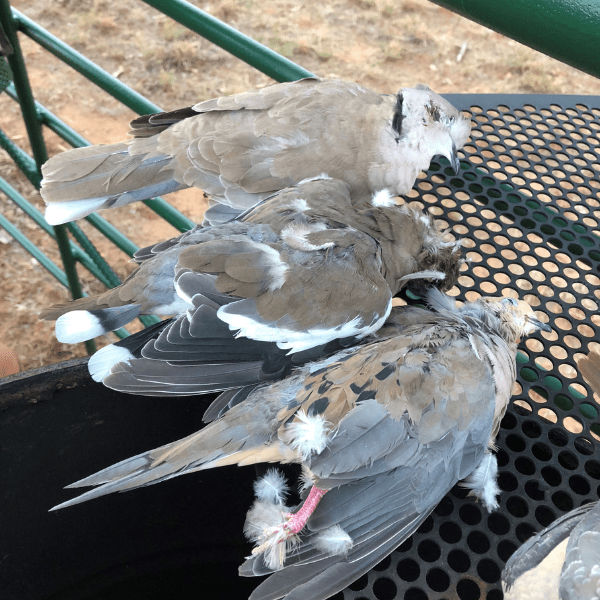
By Judy Jurek
Hunting doves in Texas is perhaps the best wing shooting anywhere. Our most hunted species are mourning, white-winged and Eurasians. Texas has seasons for mourning and whitewings while the Eurasian, considered an invasive species, may be hunted year-round. Just make sure you have a valid hunting license. Today, whitewings are scattered over most of the state west of the Pecos, so there’s a chance that you may take all three species in the same hunt.
Each fall, some 400,000 doves hunters of all genders spill out on the pastures and brushlands to take some five million or so doves of all species, and fire about 15 million shotgun shells. The good shots hunt more than the bad shots, but everyone loves doves cooked at least a half-dozen ways!
If you’re not totally familiar with each, the mourning dove is the smaller of the trio with whitewings being slightly larger. Eurasians are a bit bigger, although they’re much smaller than pigeons. White-winged doves are easily identified by the white on their outer wings that can be readily seen. Eurasians have a black neck ring, and are often called collared doves.
Dove hunting is very popular because it doesn’t require a lot of expensive equipment. You need a shotgun, ammunition, hunting license, and permission to hunt. Add in a cooler with cold beverages, perhaps a stool or chair, and camouflage clothing, if desired. Oh! Don’t forget hearing and eye protection AND knowing the bag limits and shooting hours.
Many years ago, the only whitewing doves were in deep South Texas, also known as the Rio Grande Valley. Citrus groves of grapefruit and oranges are grown way south due to milder climates, and the whitewings would migrate up from Mexico and use the citrus for roosting and nesting.
My family would annually trek to Harlingen to visit friends and hunt whitewings during the very short special white-wing only season. Young kids like me were “bird dogs” while teenage boys became shooters once they were big enough to handle a shotgun. My mother and other ladies hunted, but girls did not. Our return to Bay City had a car filled with doves, onions, fruit, and other goodies.
Fast forward from the 1960s to today, and whitewings are no longer relegated to the Rio Grande Valley. Freezes killed most of the citrus orchards in 1983, and farming practices brought the whitewings to the upper parts of the state.
Texas is divided into three hunting zones for doves: North, Central, and South. The South Zone hosts a special white-wing only season for the first two weekends of September. Otherwise, whitewing doves may be shot during dove season in all three zones.
Owen Fitzsimmons is the Webless Migratory Game Bird Program Leader for Texas Parks and Wildlife. He’s the resident dove expert. “The statewide spring count estimates 10-12 million doves in Texas but that number can go double or triple in the fall,” he said. “We use satellites, transmitters, and telemetry to track doves but it’s not a year-round count.” Of course, Texas has a lot of doves in the fall, when hunters can bring home five to six million, and cripple as much as 15%.
“Whitewings are now in every corner of the state,” Fitzsimmons said. “Mourning doves are mostly rural birds, and the whitewings are both urban and rural. They form colonies preferring to roost and nest in cities and towns, but feed on agriculture crops in the countryside. The latest big freeze of 2021 messed up much habitat for doves.” Fitzsimmons added whitewings seem to handle the cold better than mourning doves. “Both doves can find food, (by) dining on seeds, fruits, and mast,” he said. “Whitewing will perch on sorghum and sunflowers to feed, (and) mourning doves feed off the ground. Zero freezes kill more mourning doves that often roost on the ground, while whitewings always roost in small trees and brush.”
Asked about Eurasian doves, Fitzsimmons replied, “We really haven’t seen any population impacts except maybe a few localized areas. They tend to be urban and opportunistic feeders, dining in feedlots and backyard bird feeders.” I often sees collared doves under my deer feeders or in my neighbor’s yard where she feeds her chickens.
Fitzsimmons said over the years many white-winged doves may no longer be migratory although banding records show some go into Central America. Intense rainfall, hailstorms and high winds can impact breeding and recruitment (new birds being hatched). If nests or eggs are disturbed, doves can breed and nest three to four times.
What are the differences when hunting between mourning and whitewing doves? How is a hunter affected? On one hand there’s no difference because you’re there to hunt doves, whichever variety flies within shooting range. On the other hand, from this writer’s hunting experience, there’s a big variance.
Mourning doves tend to fly in singles, doubles, triples, or a small spread-out group. This allows me to carefully choose which bird to focus on to shoot. And while I’m not the most accurate wing shooter, I often fill my limit if there are plenty of birds, and I have enough shotgun shells.
Whitewings often arrive in a swift moving flight filled with numerous birds. Sometimes in a tight group. It’s quite easy to empty a shotgun’s two or three shell limit too quickly! My problem is trying to pick out one bird to shoot when a mass of winged aviators fills the air.
This results in more misses than when I only have a couple of birds coming my way. In the excitement of an overhead onslaught many hunters, myself included, tend to simply shoot into the throng, hoping one falls. Many times, a handful of mourning doves fly over with one or more whitewings in their midst or vice versa.
I also believe mourning doves tend to be more aerial stunt performers as they dip, dive, and dart from ground movement or shotgun pellets being flung at them, thus making them a harder target. To me, whitewings often tend to have a straight flight, which is easier to lead for a good shot.
Good shot or bad, it sures adds to the fun. That’s what makes dove hunting so popular: the camaraderie whether you’re hunting with a handful or a whole pasture of hunters. Doves of any kind don’t care about laughter and hollering as it’s all about movement, hence wearing camouflage and sitting in shade helps enable hunters’ success.
Any dove hunter worth their ammo knows there are times when doves fly in every direction fast and furious while other days there’s little to no action. High winds are not conducive to good hunting. Area thunderstorms or heavy rainfall in an area will move doves because they don’t like getting wet or their little feet muddy.
Dove hunting is about being outdoors with like-minded people engaging in great sport while perhaps taking home delightful dining fare for a dove-hunt party. It’s an excellent time to bring new hunters into the fold, as novice and seasoned hunters work together. Bring the youngsters to experience wing shooting at its best, for they are our future hunters.


